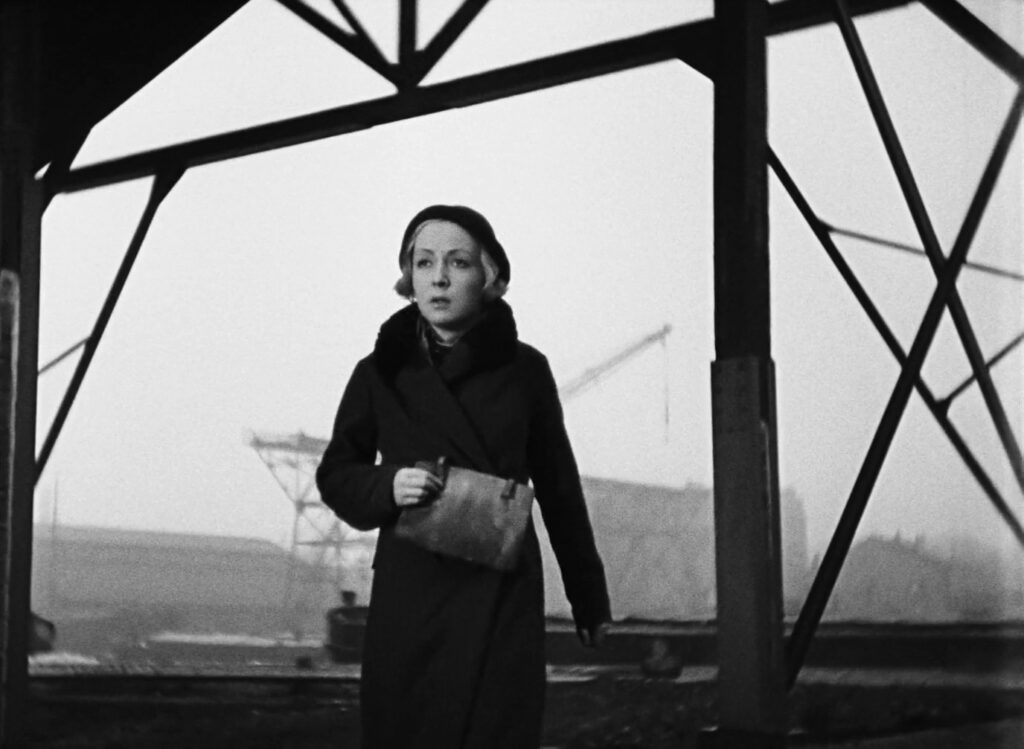
L’Atalante
1934, directed by Jean Vigo
As it approaches its conclusion, the plot of L’Atalante runs into a difficulty. Newlyweds Jean and Juliette have become separated, and the ship’s mate Père Jules sets out to find and return Juliette. Short of some miraculous chance it seems unlikely that he can locate her. Too much time and distance have passed since she left the barge. Jean, Jules, and the cabin boy have reached Le Havre at the mouth of the Seine, having left her behind upstream. A reunion might plausibly occur if she caught up with the barge and intercepted it, but that’s not what happens. She had tried that, but a thief snatched her purse as she tried to buy a ticket to Corbeil. When Jules looks for her, he can only guess where she might be. Even if he knew the town or city, finding her would still seem next to impossible.
Of all places, he finds Juliette at the “Palace Chansons”, a kind of store where patrons drop tokens into a slot to hear recordings of popular songs. Missing her husband, she plays Le chant des mariniers (The Song of the Sailors), a recent hit that transports her back to memories of the barge. Apparently the store’s mechanism broadcasts her selection through a horn onto the street outside to lure customers, and it catches Père Jules’ attention as he happens to pass by.
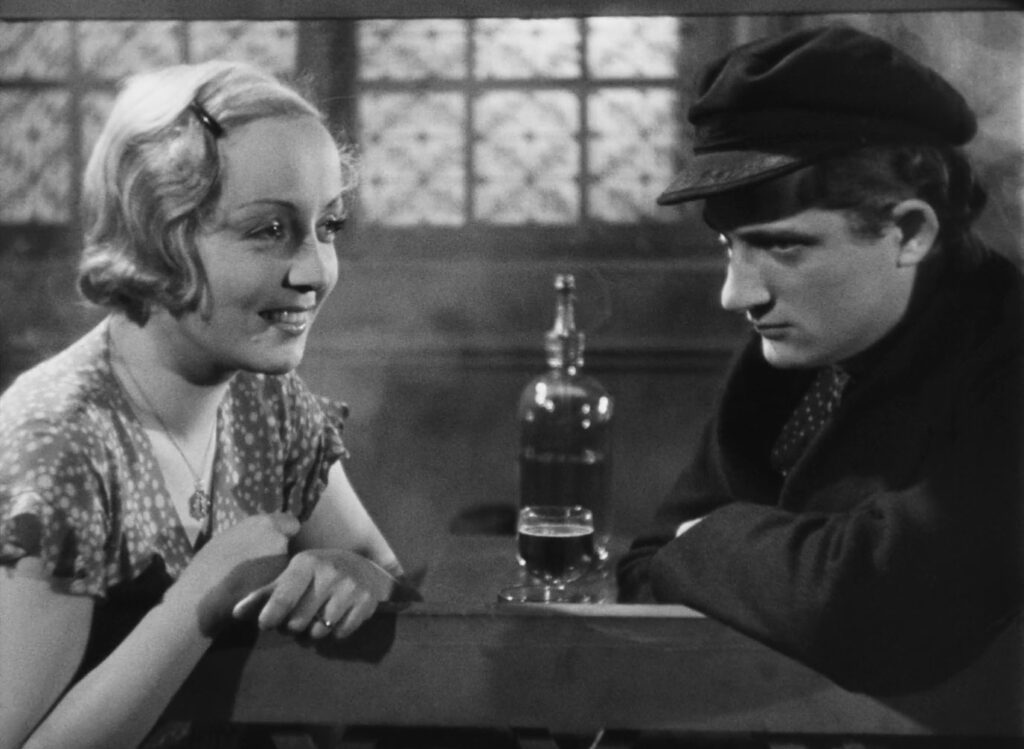
If Jules had found her back home at her native village, or in a train station, or on some bridge or quay looking for the barge, then their rendezvous might have been believable, but to find her at this music automat, at just the right moment, is too much. How can the audience accept such a remote chance? Any fan of the film is likely to argue that quibbling over such questions of logic ignores the magical spirit of L’Atalante, but are we to accept this unlikely outcome simply because we want it to happen? No – there’s a better reason. If the movie departs from the logic of events, it’s only to substitute another logic. What’s important here is that it’s a song that brings the couple back together.
The magical force of music has already been established in a running subplot about Jules’ broken phonograph. When he finally fixes it, two wondrous things happen. First, immediately after it starts working, but before he hears it, Jean dives overboard and fulfills Juliette’s claim that he’ll see his beloved’s image in the water. He had tried putting his head underwater a few times before to no avail, but now he sees a floating mirage of Juliette in a white dress. It’s as if he’s finally come to love his wife, now that he misses her. Back aboard, Jules and the cabin boy introduce Jean to the phonograph. Upon hearing it himself the second wonder occurs – it sends him into a reverie, and the film cross-cuts between him and Juliette as if they’re communicating telepathically across the distance.
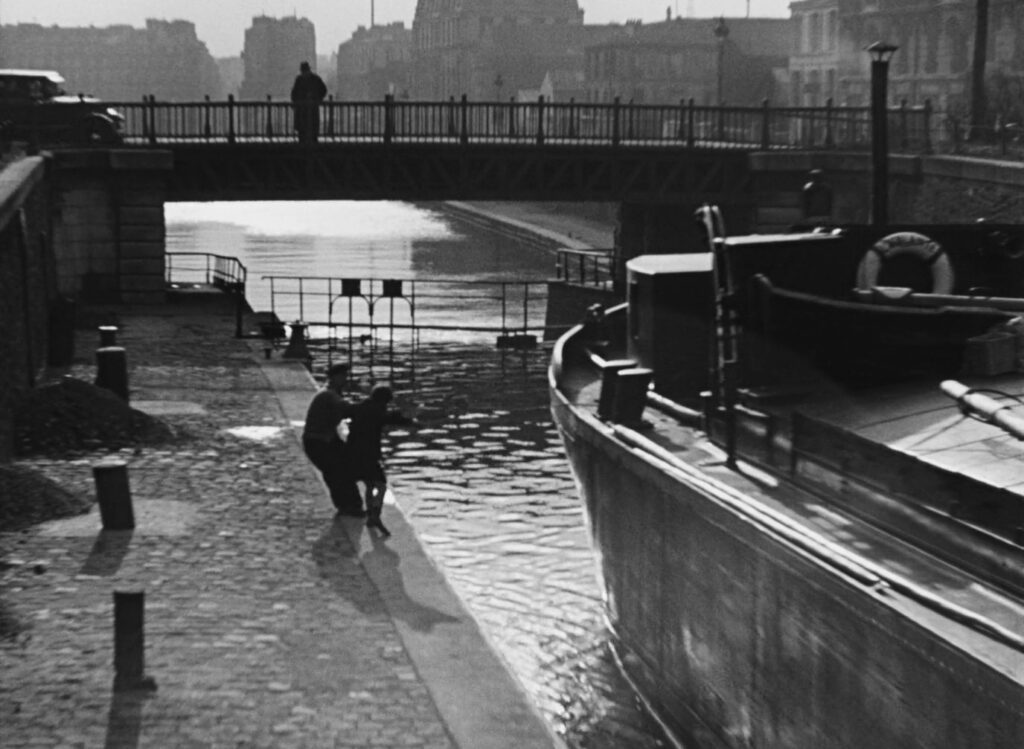
What makes these magical insinuations acceptable is the same thing that makes the impossible discovery of Juliette at the music shop believable. Both are congruent with the single idea that animates L’Atalante – the idea that art should reconnect people to life. Music stands for art in a broader sense, and it brings the couple back together, first in spirit then in physical reality.
L’Atalante is meant to be a living embodiment of this purpose, reconnecting its audience to life in the same way that music brings the troubled marriage back to life. Its defining quality is the overflowing vitality found in the acting, cinematography, and editing, especially in the irrepressible characters of Père Jules and the peddler. When we first see the newlyweds, leading a procession from the church to the barge where they’ll spend their honeymoon, their most salient quality is their lifelessness. They march stiffly, looking like the plastic figurines from a wedding cake, and the ill-tempered guests behind them are full of gossip and deprecating remarks. Jules and the cabin boy lighten things up with a comedy of errors, and henceforth the movie injects life everywhere. More often than not it goes awry, but it never stops. The idea is not that life is perfect, but that a vigorous embrace of life is needed in a world where religion, culture, work, social conflict, and routine all conspire to deaden the human spirit. Jules and the peddler exhibit the necessary antidote, shrugging off every humiliation and setback.
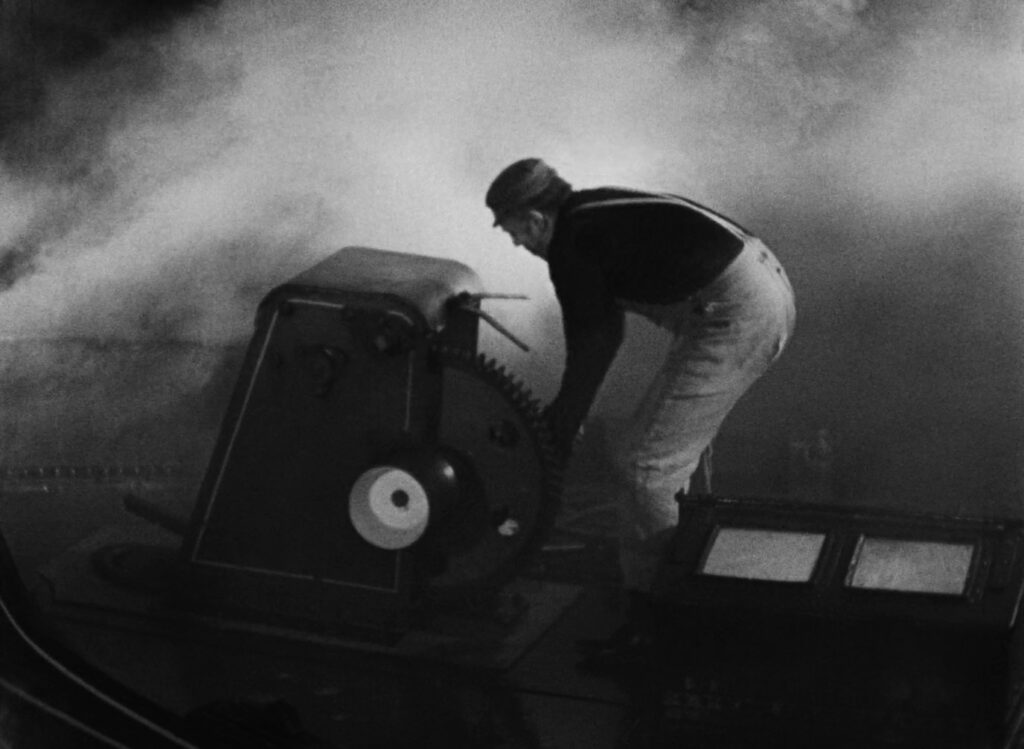
The first image of L’Atalante is an establishing shot, a static view of the ship’s prow telling us that “L’Atalante” is the name of a barge. The second shot brings the barge to life plying the river, and a cloud of steam rises from below to envelop it. The breath of life takes over completely, and from here on the barge will be a kind of life force. This image of steam as a kind of breath recurs later in a nighttime fog that leads to the couple’s embrace. Steam is a material image of spirit, and in L’Atalante‘s world there is no separation between the spiritual and the earthly. Whatever is alive is potentially full of spirit. Twice in the opening scenes a character makes the sign of the cross: first Jules outside the church, then a peasant woman watching the barge from the riverbank, each time reminding us of the forgotten member of the Trinity, the Holy Spirit, the giver of life.
The first incident on the morning after the wedding is a sign of L’Atalante‘s conscious affirmation of life. One of Père Jules’ cats delivers a litter of kittens on the marital bed, soiling the linens. The teeming animals enliven the barge, and Jules’ affinity for cats confirms his love of life. Since the phonograph is a vessel of art, life is naturally drawn to it, and the cats crowd around and nestle in its horn.
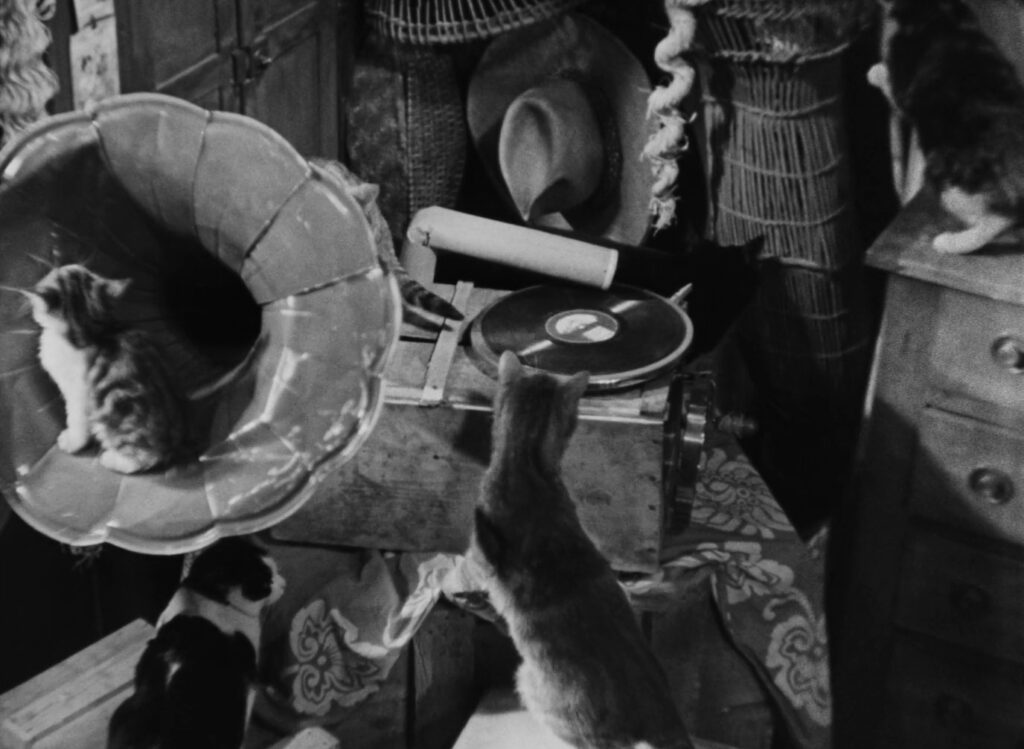
Besides the unlikely reunion with Juliette at the music booths, there’s one more strange thing about the ending. In a normal movie plot it would be Jean who looks for Juliette. Having disappointed her and driven her away, he bears the responsibility… but L’Atalante is not a conventional tale of redemption. Instead Père Jules brings her back because he’s a living piece of art with his tattoos and his love of music. In real life the task is Jean’s, but Jules is the means – at least Jules is the one who knows how to find her against all odds.
It’s easy to miss how radical this idea is, that art should reconnect us to life. It sounds like a truism until we consider what it’s reacting against. For centuries of history, in Western culture and elsewhere, whenever art has been the exclusive domain of the powerful, there’s been an idea that its purpose is to elevate its audience onto a plane higher than life. The haloed saints and angels of medieval paintings, the characters of a morality play, and the romantic ideals of 19th century music and literature all strive to lift their subjects from the morass of common life, as if there were some virtuous or ideal alternate existence to aspire to. In reality the only alternative to life is death, and much of history’s highest art has aimed for an impossible perfection that drains the life from its subjects.
L’Atalante absolutely renounces any claim to high art. Its world is thoroughly working-class, full of crude manners and humor. Père Jules is so plebeian that he gets his hair cut by a dog barber. The film’s idea of art is a simple song on an accordion, Jules’ musical toys, the peddler’s one-man marching band, a popular sailor’s tune, or Jules’ vulgar tattoos. The only prominent allusion to high art is the neo-gothic village church, its spires pointing to heaven, but whatever happens inside that church is not enough to unite the married couple with any kind of living spirit. That task is up to the “low art” of the phonograph record and the sailor’s song in the music shop.
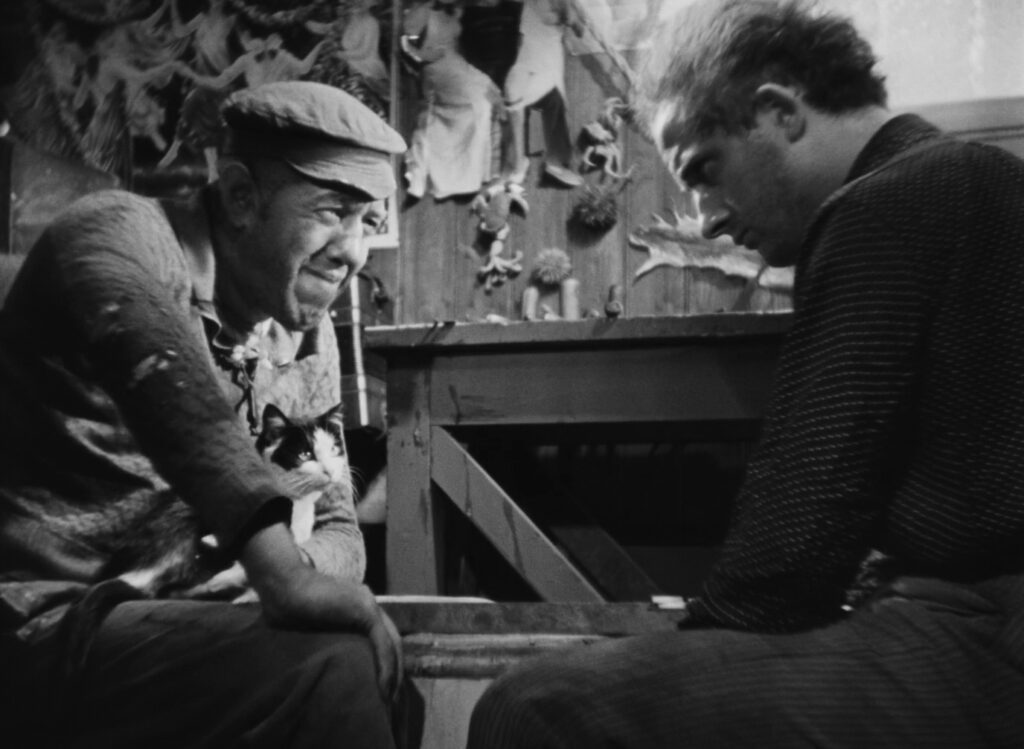
The movie’s idea of art is resolutely lowbrow, and by the same token its idea of life is bawdy, earthly, devoid of lofty pretense. The final image, an overhead shot of the long barge rising through the shimmering waves, is unashamedly sexual. L’Atalante is not so much an argument as an example of how art can match the roughness of genuine life. Instead of playing out some heroic adventure, the characters exhibit a vitality that’s fully in tune with what Virginia Woolf called the “cotton wool of daily life”. Life may be dirty, contentious, and difficult – the cat spoils the bed, the peddler gets kicked out of the dance hall, and Jean almost loses his job – but when it’s faced squarely, as the characters do, it’s totally invigorating.
CONNECTIONS:
Sunrise – Married couple’s journey of reconciliation; symbolic importance of music
Vampyr – Argument that art should connect people to life
A Man Escaped – Steam as a material image of the spiritual
Vivre sa vie – Refusal of “high art”; idea that art should not drain the life from its subject
Roselyne and the Lions – Idea that art should express the roughness of life
Wild Tales – Newlywed couple as an embodiment of both lifelessness and life